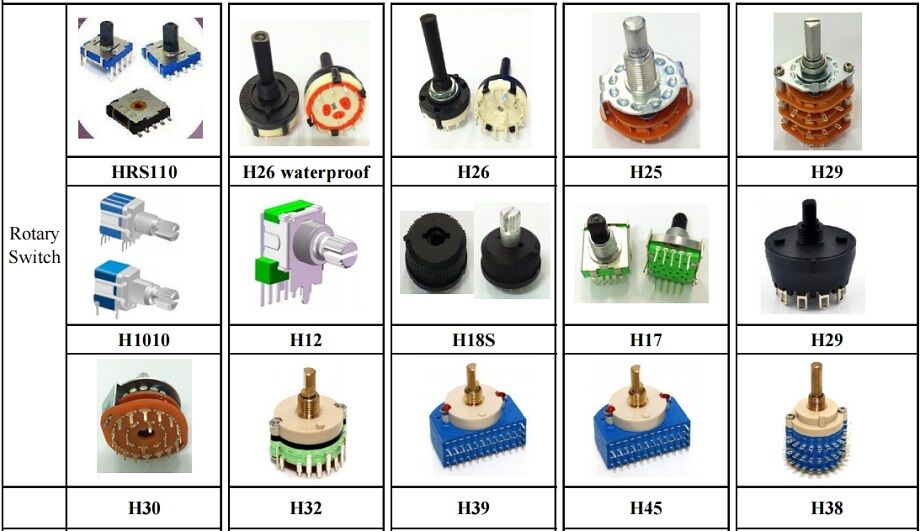

A Complete Guide to Rotary Switches
Catalog
Rotary Switch DefinitionHow Do Rotary Switches WorkTypes of Rotary SwitchesRotary Switches Offer Several AdvantagesFrequently Asked QuestionsRelated ArticlesRotary Switch Definition
Rotary switches are versatile electromechanical switches that serve as an effective alternative to pushbutton switches. They are engineered to perform a 360° rotation or advance to subsequent settings through an internal rotating shaft that permits the cap to spin. A defining feature of these switches is their capability to manage multiple circuits or functions using a single control unit. These switches come in a variety of dimensions, forms, and materials to suit different applications.


What IS A Rotary Switch?
How Do Rotary Switches Work
To understand the operation of rotary switches, consider their basic structure—a central shaft with a rotating member, often featuring an extending spoke. As this member turns within its housing, the spoke aligns with various positions, making contact with electrical terminals and thereby engaging the connected circuits or toggling the electrical state (such as switching from active to inactive). The electrical connections are routed through a circular disk known as a wafer, with the potential for multiple circuits to be linked to a single position.
Many rotary switches incorporate a rotor that has a notched or star-shaped pattern instead of a plain surface, which helps prevent the switch from getting stuck in between terminal positions. Additionally, a spring-loaded feature known as a detent is often included to prevent such stalls.
The terminals are generally arranged around the shaft at specific angular intervals—commonly at 30, 45, 60, and 90 degrees. These intervals dictate the number of different settings the switch can have.
In some rotary switches, the number of accessible positions for the user can be restricted by inserting a washer into designated slots, effectively transforming, for instance, a 12-position switch into a four-position one if that meets the application's needs.


How Do Rotary Switches Work
Types of Rotary Switches
1. Wafer Switches
Wafers, integral to most rotary switch models, facilitate the distribution of electricity from the spindle to the output terminals. In rotary wafer switches, the contacts are strategically placed on both surfaces of the wafer.
2. Yaxley Switches
Yaxley switches represent a traditional design of rotary switches that have become less common in contemporary use.
3. Miniature Rotary Switches
Compact in size, miniature rotary switches are ideal for applications where space is limited, such as on circuit boards. They typically function in a fully open or fully closed state and are often employed as sensors to monitor the position of various components.
4. High Current Rotary Switches
Engineered for higher voltage applications, high current rotary switches are constructed from materials that are resistant to electrical discharge, with both the casing and contact points being reinforced for durability.
5. Rotary Cam Switches
Rotary cam switches are characterized by a shaft that adjusts the electrical resistance at the connected contact points when rotated, making them suitable for electronic devices that require variable current control.
6.Rotary DIP Switches
Rotary DIP switches are arrays of switches arranged in a dual in-line package, a standard configuration commonly utilized on printed circuit boards and other electronic components. Also referred to as DIL switches, they are employed to modify the electrical response of the device in which they are integrated.
7.Binary Rotary Switches
Binary rotary switches are a compact design intended for use in sensitive electronic equipment, employing a binary system for on-off control.
8. Momentary Rotary Switches
Momentary rotary switches are employed in various electrical circuits to provide a temporary change in state, such as transitioning between circuits or toggling an on-off function. These switches revert to their default position once the pressure is released.
9.PCB Mount Rotary Switches
PCB mount rotary switches are vertically mounted controls on printed circuit boards (PCBs), used for managing multiple output terminals.
10.Heavy-Duty Rotary Switches
Built to withstand tough conditions, heavy-duty rotary switches offer robust mechanical control in challenging industrial settings.


Types of Rotary Switches
Rotary Switches Offer Several Advantages
1. Multi-Position Capability: Rotary switches are designed to manage a variety of positions, which makes them perfect for controlling intricate systems from a single interface. This feature is especially beneficial in devices that need to access multiple functions or settings.
2. Longevity: Known for their sturdy construction, these switches can endure many rotation cycles without failure, ensuring their dependability for extended periods of use.
3. Tactile Feedback: The physical sensation of rotating to a specific setting offers clear feedback, which is crucial in environments where the user may not be able to visually monitor the switch.
4. Adaptability: Rotary switches can seamlessly perform a range of functions, whether it's adjusting voltage, changing power levels, or toggling between different modes.
5. Accurate Adjustment: The defined positions on rotary switches help users stay informed about the current configuration and safely reach their intended settings.
6. Space-Efficient Design: Coming in various sizes, rotary switches are mechanically engineered to take up minimal space, fitting well in applications with limited area availability.
7.User-Friendly Interface: The rotational action provides an intuitive and accurate way to control functions, enabling users to effortlessly choose the function they need.
8.Safety Features: Certain rotary switches include a break-before-make mechanism that prevents short circuits during operation, thereby increasing safety.
9.Tailor-Made Options: With a range of contact materials and configurations available, rotary switches can be tailored to meet the specific requirements of various applications.
10.Streamlined Device Architecture: By integrating multiple switching functions into a single unit, rotary switches can simplify both the design and operation of complex equipment.


Rotary Switches
Frequently Asked Questions
1. Purpose of Rotary Switches
Rotary switches are utilized to link a functional circuit within a device to an electrical power source. The electrical current enters the switch and is then routed to the circuit that the switch has been set to select.
2.Description of a Rotary Switch
A rotary switch is operated by turning it. They are often preferred when more than two settings are required, such as in a three-speed fan or a CB radio with various reception frequencies or "channels". A three-deck rotary switch enables the control of three distinct circuit functions.
3. Difference Between Rotary and Selector Switches
A rotary switch alternates contacts and connections as the spindle is turned in either direction. A selector switch uses a rotating handle to activate or deactivate circuits at different current levels, managing various circuits with a single switch.
4. Common Uses for Rotary Switches
Rotary switches are widely used in applications such as radios, vehicles, and industrial machinery. They are dependable and adaptable, capable of performing more complex tasks than just basic on-off switching.
5. Distinction Between Rotary and DIP Switches
DIP and coded rotary switches are employed to produce coded outputs for electronic devices. DIP (Dual In-Line Package) switches offer settings across 2-12 positions, while coded rotary switches operate through the rotation of a central shaft that moves the attached contacts.
6. Benefit of Rotary Switches
Increased Versatility: A primary benefit of rotary switches is their adaptability. These switches can feature multiple settings, enabling them to manage a broad spectrum of functions.
7. Operation of Rotary Switches
A rotary switch comprises a rotating shaft with a rotor and a moving contact or disk connected to a contact plate. The rotation of the shaft or disk causes the contacts to either separate or join, which in turn either completes or interrupts the circuit with the contact housing.
8. Primary Functions of Switches
Switches fulfill their roles by performing four fundamental functions: Learning, Forwarding, Filtering, and Flooding. These functions are inherent in switches and are available from the moment they are unpacked.
Related Articles
Subscribe to JMBom Electronics !













